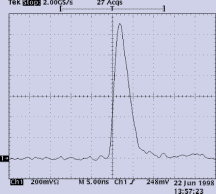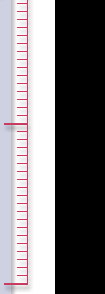
Question I design instruments that use laser light. How can you help me? Answer Over 70% of our business is to OEM accounts. Click on the link to our OEM Capabilities page to learn more. Then contact us so that we might propose a laser to meet your needs. Our staff of optical, electrical, and mechanical engineers is experienced in devising and implementing practical and cost-effective laser solutions. Question What is a nitrogen laser? Answer The word laser is an acronym of Light Amplification by Stimulated Emission of Radiation. A laser consists of a cavity filled with lasable material and fitted with mirrors at both ends. The molecules of a lasable material are capable of being excited or pumped to a semistable state by an electric discharge or light. The light emitted by a molecule as it drops back to the ground state releases light from other nearby, excited molecules. Light oscillates back and forth between the mirrors and continually increases in intensity. If one mirror is made to transmit part of the light, a brilliant beam of highly monochromatic, coherent radiation is emitted through the mirror. In our nitrogen lasers, a spark gap excites or pumps the nitrogen gas molecules in the laser cavity. The laser produces pulsed radiation at 337.1 nm in the UV. Question Why is the nitrogen laser pulsed? Answer When nitrogen molecules are pumped to the excited state, they de-excite first to an intermediate excited state and then to the ground state. The upper excited state of nitrogen has an extremely short lifetime (40 ns) compared to the intermediate level (10 µs). By rapid pumping with a fast spark gap switch, the upper level is momentarily populated. Because the lower level has a much longer lifetime, it soon dominates and stops the laser amplification. The excited state is repopulated by the spark gap and laser radiation is produced again until the lower level once again dominates. Our nitrogen lasers deliver pulses on the order of 4 ns in duration. Question How can I use a pulsed laser when my experiment requires CW (continuous wave) radiation? Answer We would like you to talk to us about your application. In many cases, pulsed sources have advantages. A pulsed laser can deliver much greater peak power than a CW laser of comparable size. The pulsed laser can produce the desired effect such as laser induced fluorescence or ablation (microsurgery), but because the laser is off most of the time, damage to the sample matrix is sharply reduced or eliminated. Because the source is pulsed or modulated, the sample signal can often be separated from other signals such as noise or fluorescence. In such a case, detection limits can be drastically decreased. Materials can be detected at lower concentrations and smaller samples can be measured. Our technical staff can help you configure a system for your experiment. We have experience in detecting pulsed light. Please talk to us before you decide. Question How can I detect pulsed light? Answer There are many ways to detect pulsed light. Fast detectors such as photodiodes and PMTs (photomultiplier tubes) can detect individual pulses from our lasers. A gated integrator connected to the detector captures the detector response. The laser and the gated integrator are simultaneously triggered from a TTL pulse. As an example, the laser radiation may interact with a sample to produce fluorescence. When the fluorescent emission strikes the detector, the gated integrator captures the total photocurrent during the fluorescence decay. Again, we will be happy to help you configure a system to perform your experiments. Question How long will my laser last? Answer Laser energy output decreases with both time and usage. Our nitrogen plasma cartridges are warranted to maintain at least 70% of their energy for twenty million pulses or two years, whichever occurs first. Our µ-TEA CO2 plasma cartridge has a warranted lifetime of greater than 5 million shots or one year, whichever occurs first. Replacement plasma cartridges include all the components that deteriorate with usage: energy storage capacitors, the switching element, the plasma tube and mirrors, the electrodes, and the preionizers. Once the plasma cartridge is replaced, the laser performs like new again, and at a fraction of the cost! Question What is the relationship between energy, average power, and peak power? Answer A nitrogen laser output waveform taken from an oscilloscope is shown below. This waveform represents laser output power as a function of time. The highest point on the waveform is the peak power and is specified as 75 kW for our VSL-337ND-S nitrogen laser. The waveform is roughly triangular in shape. The pulse width is given as 4 ns FWHM (Full Width Half Maximum), which means the measurement points are taken at the half-power points of the waveform.
Question How can I measure pulse energy? Answer Laser energy is commonly measured with a joule meter or a power meter. A power meter is used for CW (continuous wave) lasers. Typically the electronics in a power meter are not fast enough to capture the short (4 ns) pulse from our nitrogen lasers. A joule meter along with a pyroelectric detector are used to measure pulse energy on our nitrogen lasers. This combined system must have the sensitivity to measure microjoules of pulse energy, frequencies up to 60 Hz, be appropriate for the wavelength you are measuring, and have a large enough detective head to capture the entire beam. Proper placement of the detector in the laser beam path is critical. It should be placed at a small angle, so the laser beam is not reflected back into the laser, resulting in an inaccurate, unstable energy measurement. Question How small of a spot size can I focus my laser down to? Answer The focused spot size depends on the wavelength of laser light, the beam divergence of the laser, and the focal length of the lens. An aberration corrected microscope objective is used for achieving the smallest spots. With such a lens, our VSL-337ND-S nitrogen laser with output at 337 nm and a beam divergence of 0.3 mrad, can be focused to less than 1 µm. Our dye lasers have a beam divergence of 4 mrads. A dye laser tuned to 500 nm can be focused to a spot of about 8 µm. Question Can you attach your laser to my microscope? Answer To use our laser to microscope adapters, the microscope must have an EPI port or EPI-fluorescence illuminator. Our laser to microscope adapters attach to the EPI port. The microscope filter cube must have a dichroic mirror that reflects the laser wavelength to the sample and a barrier filter to block any laser light reflected to the eyepiece. The exciter filter is removed. We offer a mirror housing that accommodates the attachment of multiple light sources to the EPI port. Because we customize each laser to microscope adapter, we will send you a Microscope Measurement Kit and ask you to make a few simple determinations. This way we can select the optimum optical components to attach our laser to your microscope. To learn more go to the Microbeam System page or contact us directly. Can’t find your question here? See Make Your Own FAQ! |
| © 2000-2025 Laser Science,
Inc. All Rights Reserved |
|
|




